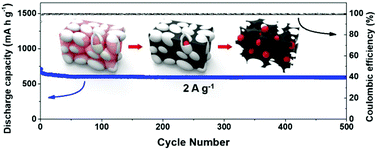Fe3O4 nanoparticle decorated three-dimensional porous carbon/MoS2 composites as anodes for high performance lithium-ion batteries†
Abstract
Molybdenum disulfide (MoS2) is a promising anode material for lithium-ion batteries owing to its high theoretical capacity and low cost. However, it exhibits low electrical conductivity and volume expansion, resulting in poor electrochemical performance. In this work, three-dimensional porous carbon/MoS2 composites with Fe3O4 nanoparticles (C-MF) are synthesized via a mix–bake–wash method. The few-layered MoS2 in the porous carbon matrix provides improved electrical conductivity and facilitates lithium ion diffusion, so the composites exhibit a high specific capacity of 939.6 mA h g−1 on average at 0.1 A g−1 and a high rate capability (515.9 mA h g−1 at 5 A g−1). Moreover, the Fe3O4 nanoparticles in C-MF, which are anchored on the composites, improve the specific capacity and effectively mitigate diffusion of lithium polysulfides during cycling, resulting in remarkable cycling stability (590.1 mA h g−1 after 500 cycles at 2 A g−1). This work suggests that not only C-MF but also C@MoS2 with other metal oxides synthesized using this facile strategy have potential for energy-related applications.



 Please wait while we load your content...
Please wait while we load your content...